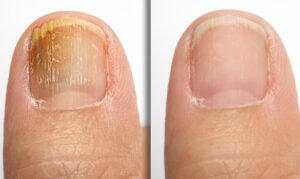Brittle Nails
Think of your fingernails as brick and mortar, says Paul Kechijian, M.D., clinical associate professor of dermatology and chief of the nail section at New York University Medical Center in New York City. As you age, the “bricks” that are your nail cells and the “mortar” that holds them together gradually break down. Your nails become brittle. That’s why the problem is more common among people over 65. Everyone has brittle nails to some extent, some more than others. “A lack of moisture doesn’t cause the problem but it can worsen an already brittle condition,” says Dr. Kechijian. Here’s how to make things better.
Try This First
Reach for hand cream. Apply a moisturizing hand cream to your nails and hands frequently. The cream traps the moisture in your nails and keeps them from drying out, says Dr. Kechijian. “This is a wise step for any person who constantly wets and dries his hands during the course of a day.” Nails expand when they absorb water then contract like an accordion when they dry, so he suggests applying a hand cream immediately after you dry your hands.
Any over-the-counter cream should do the trick, says C. Ralph Daniel III, M.D., clinical professor of dermatology at the University of Mississippi Medical Center in Jackson.
Whatever hand cream you pick, buy several small tubes of it and leave them all over the place—in your pocketbook, in your desk drawer, beside the kitchen sink. That way, you’ll always have some on hand, says Dee Anna Glaser, M.D., associate professor of dermatology at St. Louis University School of Medicine.
Other Wise Ways
Horse around with biotin. Years ago, Dr. Daniel says, researchers found that the B vitamin biotin increased the toughness of horses’ hooves. Doctors saw the positive results in horses and concluded that biotin might have the same effect on human nails. Biotin may thicken nails and can prevent cracking and splitting, Dr. Daniel says. To get biotin in your diet, fill your glass with milk and your plate with servings of corn, barley, cauliflower, and legumes such as peanuts and soybeans. But you’ll have to take biotin supplements to get the amount you need for brittle nails, Dr. Daniel continues. For four to six months, take 300 micrograms four times a day with food. This should provide the necessary amount of biotin and could increase your nail thickness over a six-month period.
Keep them short and sweet. If you’re bothered by brittle nails, Dr. Kechijian advises that you trim them shorter. Shorter nails are much less likely to be injured or get caught on something and tear. To keep nails strong, they should be cut straight across and rounded slightly at the edges. Use sharp nail scissors or clippers. He also recommends cutting your nails after washing, when they’re softer, less brittle, and less likely to break. File away any rough edges by stroking the nail file in one direction—not back and forth. “And don’t use your nails like a screwdriver or crowbar,” he adds.
Glove ’em or leave ’em. If washing dishes is one of your daily chores, Dr. Daniel suggests investing in several pairs of vinyl gloves with cotton liners. The vinyl outside keeps the water off your nails, while the cotton liner absorbs sweat so that your nails won’t get wet inside the gloves.
Watch your washing. Good hygiene is certainly important, but if you’re prone to brittle nails, don’t wash and dry your hands any more than you have to, says Dr. Daniel. Although you’d think that wetting your hands would keep them moist, frequently washing and drying them actually strips away the moisture in and around your nails. That may also cause them to dry out and become brittle.
Go acetate, not acetone. Take a look at the ingredients list of your nail polish remover. It should be made with acetate, not acetone, Dr. Daniel says. “Acetone nail polish removers are stronger, but they can take much-needed moisture out of your nails and can perhaps lead to the nails becoming more brittle. I recommend nail polish removers with acetate because they are less likely to dry out a person’s nails,” he says.










 English (US) ·
English (US) ·